Norma Shearer
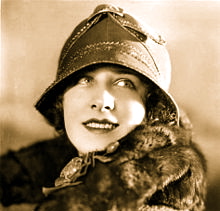
Norma Shearer Biography
A biography on silent and talkie film actress Norma Shearer. The music is If I could tell you by Yanni. A child model and bit player in New York-based films whose appearance in “The Stealers” (1920) caught the attention of producer Irving Thalberg. Thalberg signed Shearer to a long-term contract with MGM in 1923 and she quickly became a popular star in such films as “He Who Gets Slapped” (1924), “His Secretary” (1925) and “The Student Prince” (1927), typically as a gentle but vivacious ingenue. Thalberg married his star in 1927, after which she had her pick of films, parts and directors. A striking and often lovely brunette actress with a great profile, Shearer compensated for a slight lack of conventional beauty with great poise, elegance and charm. She played a wide range of roles in a glittering array of films; among her most notable efforts were “The Divorcee” (1930), for which she won an Oscar, “A Free Soul” (1931), “Private Lives” (1931; an especially fine and rare comic performance at this stage in her career), “Smilin’ Through” (1932; one of her loveliest performances, and most romantic films) and “Romeo and Juliet” (1936).
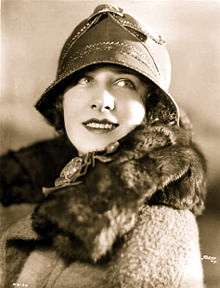 Norma Shearer in a studio publicity still
Norma Shearer in a studio publicity still
Edith Norma Shearer (August 10, 1902 – June 12, 1983) was a Canadian actress. Shearer was one of the most popular actresses in North America from the mid-1920s through the 1930s. Her early films cast her as the girl-next-door, but for most of the Pre-Code film era (beginning with the 1930 film The Divorcee, for which she won the Academy Award for Best Actress), she played sexually liberated women in sophisticated contemporary comedies. Later she appeared in historical and period films.
Unlike many of her Metro-Goldwyn-Mayer contemporaries, Shearer’s fame declined steeply after retirement. By the time of her death in 1983, she was largely remembered at best for her “noble” roles in The Women, Marie Antoinette and Romeo and Juliet. Shearer’s legacy began to be re-evaluated in the 1990’s with the publication of two biographies and the TCM and VHS release of her films, many of them unseen since the implementation of the Production Code some sixty years before. Focus shifted to her pre-Code “divorcee” persona and Shearer was rediscovered as “the exemplar of sophisticated 1930’s womanhood… exploring love and sex with an honesty that would be considered frank by modern standards.”
Simultaneously, Shearer’s ten-year collaboration with portrait photographer George Hurrell and her lasting contribution to fashion through the designs of Adrian were also recognized.
Shearer is widely celebrated by some as one of cinema’s feminist pioneers: “the first American film actress to make it chic and acceptable to be single and not a virgin on screen.” In March 2008, two of her most famous pre-code films, The Divorcee and A Free Soul, were released on DVD.
Early Life
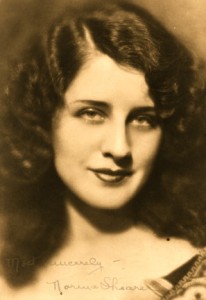 Shearer’s childhood was spent in Montreal and was one of privilege due to the success of her father’s construction business. However, the marriage between her parents was not a happy one. Andrew Shearer was prone to manic depression and “moved like a shadow or a ghost around the house,” while her mother Edith was attractive, flamboyant and stylish, prompting gossip that she was a heroin addict and unfaithful to her husband. Neither rumor was ever proven, but Edith proved to be bored with her marriage very early on and focused her energy on Norma, who she decided would one day become a famous concert pianist.
Shearer’s childhood was spent in Montreal and was one of privilege due to the success of her father’s construction business. However, the marriage between her parents was not a happy one. Andrew Shearer was prone to manic depression and “moved like a shadow or a ghost around the house,” while her mother Edith was attractive, flamboyant and stylish, prompting gossip that she was a heroin addict and unfaithful to her husband. Neither rumor was ever proven, but Edith proved to be bored with her marriage very early on and focused her energy on Norma, who she decided would one day become a famous concert pianist.
Shearer was interested in music as well, but after seeing a vaudeville show for her ninth birthday, announced her intention to become an actress. Edith offered support but, as Shearer entered adolescence, became secretly fearful that her daughter’s physical flaws would jeopardize her chances. Shearer herself “had no illusions about the image I saw in the mirror.” She acknowledged her “dumpy figure, with shoulders too broad, legs too sturdy, hands too blunt”, and was also acutely aware of her small eyes that appeared crossed due to a cast in her right eye. But by her own admission, she was “ferociously ambitious, even as a young girl” and planned to overcome her deficiencies through careful camouflage, sheer determination and charm.
The childhood and adolescence that Shearer once described as “a pleasant dream” ended in 1918, when her older sister, Athole, suffered her first serious mental breakdown and her father’s company collapsed. Forced to move into a small, dreary house in a “modest” Montreal suburb, the sudden plunge into poverty only strengthened Shearer’s determined attitude: “At an early age, I formed a philosophy about failure. Perhaps an endeavor, like my father’s business, could fail, but that didn’t mean Father had failed.”
Edith Shearer thought otherwise. Within weeks, she had left her husband and moved into a cheap boarding house with her two daughters. A few months later, encouraged by her brother, who believed his niece should try her luck in “the picture business”, then operating largely on the East Coast, Edith sold her daughter’s piano and bought three train tickets for New York. Also in her pocket was a letter of introduction for Norma, acquired from a local theatre owner, to Florenz Ziegfeld, who was currently preparing a new season of his famous Ziegfeld Follies.
Early Career
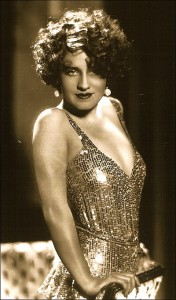 In January 1920, the three Shearer women arrived in New York, each of them dressed up for the occasion. “I had my hair in little curls,” Shearer remembered, “and I felt very ambitious and proud.” Her heart sank, however, when she saw their rented apartment: “There was one double bed, a cot with no mattress and a stove with one gas jet. The communal bathroom was at the end of a long dimly lit hallway. Athole and I took turns sleeping with mother in the bed, but sleep was impossible anyway—the elevated trains rattled right past our window every few minutes.”
In January 1920, the three Shearer women arrived in New York, each of them dressed up for the occasion. “I had my hair in little curls,” Shearer remembered, “and I felt very ambitious and proud.” Her heart sank, however, when she saw their rented apartment: “There was one double bed, a cot with no mattress and a stove with one gas jet. The communal bathroom was at the end of a long dimly lit hallway. Athole and I took turns sleeping with mother in the bed, but sleep was impossible anyway—the elevated trains rattled right past our window every few minutes.”
The introduction to Ziegfeld proved equally disastrous. He turned Shearer down flat, reportedly calling her a “dog,” and criticized her crossed eyes and stubby legs. She continued doing the rounds with her determination undimmed: “I learned that Universal Pictures was looking for eight pretty girls to serve as extras. Athole and I showed up and found fifty girls ahead of us. An assistant casting director walked up and down looking us over. He passed up the first three and picked the fourth. The fifth and sixth were unattractive, but the seventh would do, and so on, down the line until seven had been selected—and he was still some ten feet ahead of us. I did some quick thinking. I coughed loudly and, when the man looked in the direction of the cough, I stood on my tiptoes and smiled right at him. Recognizing the awkward ruse to which I’d resorted, he laughed openly and walked over to me and said, ‘You win, Sis. You’re Number Eight.'”
Other extra parts followed, including one in Way Down East, helmed by director D. W. Griffith. Taking advantage of a break in filming and standing shrewdly near a powerful arc light, Shearer introduced herself to Griffith and began to confide her hopes for stardom. “The Master looked down at me, studied my upturned face in the glare of the arc, and shook his eagle head. Eyes no good, he said. A cast in one and far too blue; blue eyes always looked blank in close-up. You’ll never make it, he declared, and turned solemnly away.”
Still undeterred, Shearer risked some of her savings on a consultation with Dr. William Bates, a pioneer in the treatment of incorrectly aligned eyes and defective vision. He wrote out a series of muscle-strengthening exercises that, after many years of daily practice, would successfully conceal Shearer’s cast for long periods of time on the screen. She spent hours in front of the mirror, exercising her eyes and striking poses that concealed or improved the physical flaws noted by Ziegfeld or Griffith. At night, she sat in the galleries of Broadway theatres, studying the entrances of Ina Claire, Lynn Fontanne, and Katharine Cornell.
In desperate need of money, Shearer resorted to some modeling work, which proved successful. On her modeling career, she commented: “I could smile at a cake of laundry soap as if it were dinner at the Ritz. I posed with a strand of imitation pearls. I posed in dust-cap and house dress with a famous mop, for dental paste and for soft drink, holding my mouth in a whistling pose until it all but froze that way.” She became the new model for Kelly-Springfield Tires, was bestowed with the title “Miss Lotta Miles” and depicted seated inside the rim of a tire, smiling down at traffic from a large floodlit billboard. Years later, MGM rival Joan Crawford would disparagingly refer to Shearer as “Miss Lotta Miles.”
Finally, a year after her arrival in New York, she received a break in film: fourth billing in a B-movie titled The Stealers (1921). More silent films followed, which brought her to the attention of producer Hal Roach, out from Hollywood searching for new talent. Early in 1923, after a successful meeting, Roach made Shearer an offer on behalf of Louis B. Mayer Pictures, run by mogul Louis B. Mayer. After three years of hardship, she found herself signing a contract for $250 a week for six months, with options for renewal and a test for a leading role in a major film called The Wanters.
Hollywood
Shearer left New York in the spring of 1923. Accompanied by her mother, she felt “dangerously sure of herself” as her train neared Los Angeles. Still not welcomed an hour after her arrival, she realized that there would be no star treatment from her new studio. Dispirited, she allowed Edith to hail them a taxi.
The next morning, Shearer went to the Mayer Company on Mission Road to meet with the vice-president, Irving Thalberg. Shearer was momentarily thrown by their confused introduction, but soon found herself “impressed by his air of dispassionate strength, his calm self-possession and the almost black, impenetrable eyes set in a pale olive face.”
The Actress
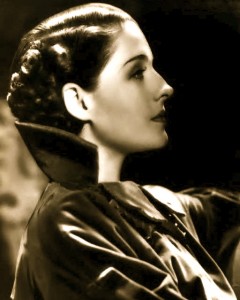 Shearer was less impressed, however, with her first screen test: “The custom then was to use flat lighting—to throw a great deal of light from all directions, in order to kill all shadows that might be caused by wrinkles or blemishes. But the strong lights placed on either side of my face made my blue eyes look almost white, and by nearly eliminating my nose, made me seem cross-eyed. The result was hideous.”
Shearer was less impressed, however, with her first screen test: “The custom then was to use flat lighting—to throw a great deal of light from all directions, in order to kill all shadows that might be caused by wrinkles or blemishes. But the strong lights placed on either side of my face made my blue eyes look almost white, and by nearly eliminating my nose, made me seem cross-eyed. The result was hideous.”
The day after the test had been screened for Mayer and Thalberg, cameraman Ernest Palmer found Shearer frantic and trembling in the hallway. Speaking with her, he was struck by her “fierce, almost raging disappointment” and, after viewing the test himself, agreed that she had been “poorly handled.” Under Palmer’s own supervision, a second test was made and judged a success by the studio brass. The lead in The Wanters seemed hers, until the film’s director objected, finding her “unphotogenic.” Again, Shearer was to be disappointed, relegated to a minor role.
She accepted her next role in Pleasure Mad, knowing “it was well understood that if I didn’t deliver in this picture, I was through.” After only a few days of shooting, things were not looking good. Shearer was struggling. Finally, the film’s director complained to Mayer that he could get nothing out of the young actress, and when summoned to Mayer’s office, she fully expected the axe to fall: “But to my surprise, Mr. Mayer’s manner was paternal. ‘There seems to be a problem,’ he said, ‘tell me about it.’ I told him that the director had shouted at me and frightened me. Nobody had warned me that Mayer was a better actor than any of us, and I was unprepared for what happened next. He staged an alarming outburst, screaming at me, calling me a fool and a coward, accusing me of throwing away my career because I couldn’t get on with a director. It worked. I became tearful, but obstinate. ‘I’ll show you!’ I said to him. ‘You’ll see!’ Delighted, Mayer resumed the paternal act. ‘That’s what I wanted to hear,’ he said, smiling.” Returning to the set, Shearer plunged into an emotional scene. “I took that scene lock, stock, and barrel, fur, fins and feathers,” she remembered, earning her the respect of her director and her studio. As a reward, Thalberg cast her in six films in eight months.
It was an apprenticeship that would serve Shearer well. By the time Metro-Goldwyn-Mayer was formed in 1924 and she was cast in the studio’s first official production, He Who Gets Slapped, she had become one of MGM’s biggest box-office attractions. In 1925, she signed a new contract paying her $1,000 a week, rising to $5,000 over the next five years. Soon after, she bought a house for herself and Edith, right under the Hollywood Sign, at 2004 Vine Street.
Irving Thalberg
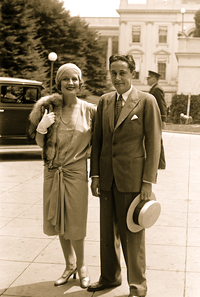 Shearer alongside Irving Thalberg, outside the White House in 1929
Shearer alongside Irving Thalberg, outside the White House in 1929
Having become a star, Shearer’s new challenge was to remain one. There were many other talented actresses at the studio and she realized she would have to fight hard to stay ahead of the pack. Seeing that sensational newcomer Greta Garbo was one of a kind, she went to Thalberg and “demanded recognition as one of another kind.” It was just one of the many visits she paid to his office, always to plead for better material, better parts. Thalberg would listen patiently, then invariably advise Norma to keep toeing the line, that MGM knew best, and that the movies she complained about had made her a popular actress. Occasionally Shearer would burst into tears, but this seemed to make “no more impression than rain on a raincoat.”
Privately, Thalberg was very impressed by Shearer. In a story conference, when her name was suggested to him for the part of a girl threatened with rape, Thalberg shook his head and, with a wry smile, said, “She looks too well able to take care of herself.”
Shearer, for her part, found herself increasingly attracted to her boss. “Something was understood between us, an indefinite feeling that neither of us could analyse.” Thalberg’s appeal was not primarily sexual. What attracted Shearer was his commanding presence and steely grace; the impression he gave that wherever he sat was always the head of the table. In spite of his youth, Thalberg became a father figure to the 23-year-old actress.
At the end of a working day in July 1925, Shearer received a phone call from Thalberg’s secretary, asking if she would like to accompany Thalberg to the premiere of Chaplin’s The Gold Rush. That night, they made their first appearance as a couple. A few weeks later, Shearer went to Montreal to visit her father. While there, she had a reunion with an old school friend, who remembered: “At the end of lunch, over coffee, Norma leant in across the table. ‘I’m madly in love,’ she whispered. ‘Who with?’ I asked. ‘With Irving Thalberg,’ she replied, smiling. I asked how Thalberg felt. ‘I hope to marry him,’ Norma said, and then, with the flash of the assurance I remembered so well, ‘I believe I will.'”
“It is impossible to get anything major accomplished without stepping on some toes. Enemies are inevitable when one is a ‘doer’.” — Norma Shearer
http://www.tcm.com/tcmdb/person/175586|118297/Norma-Shearer/

